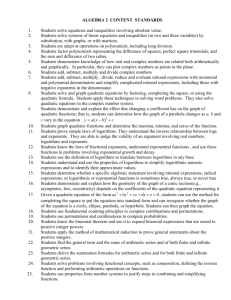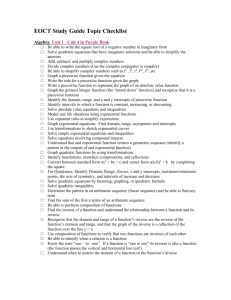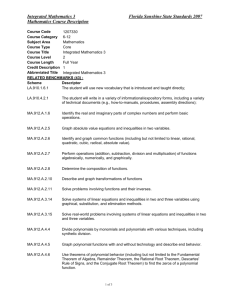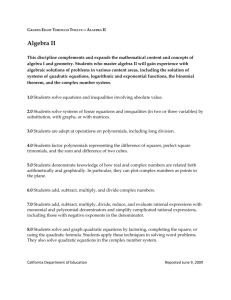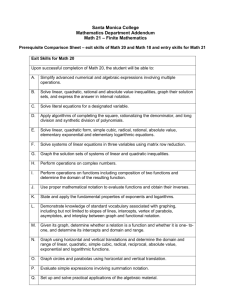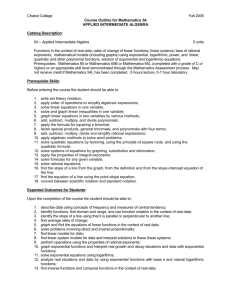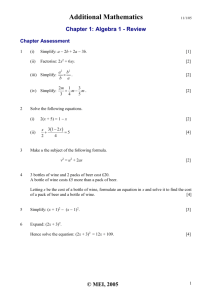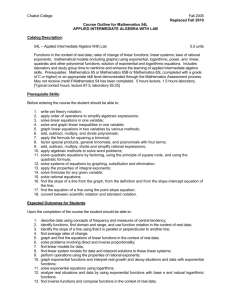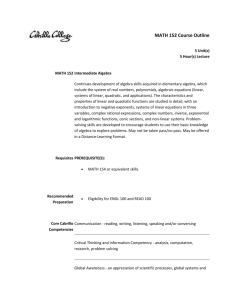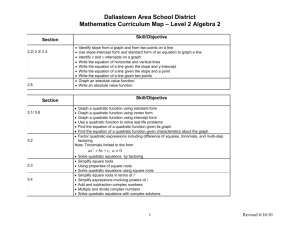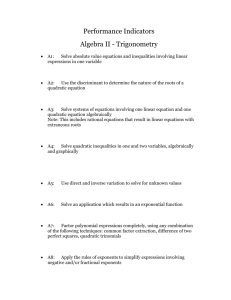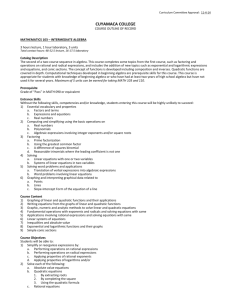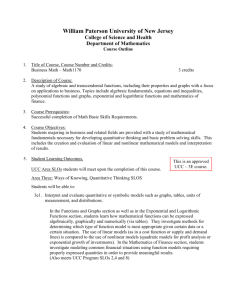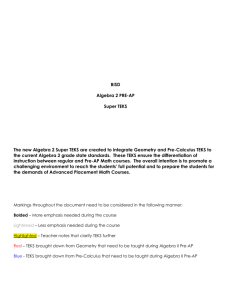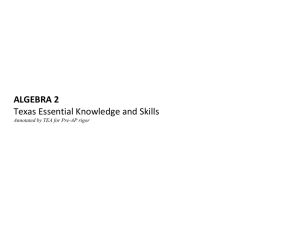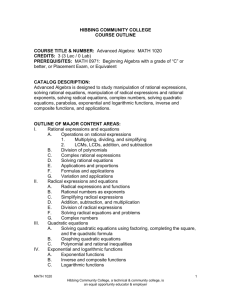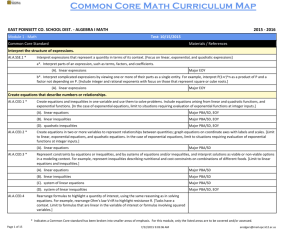Math 131 Course SLO`s
advertisement
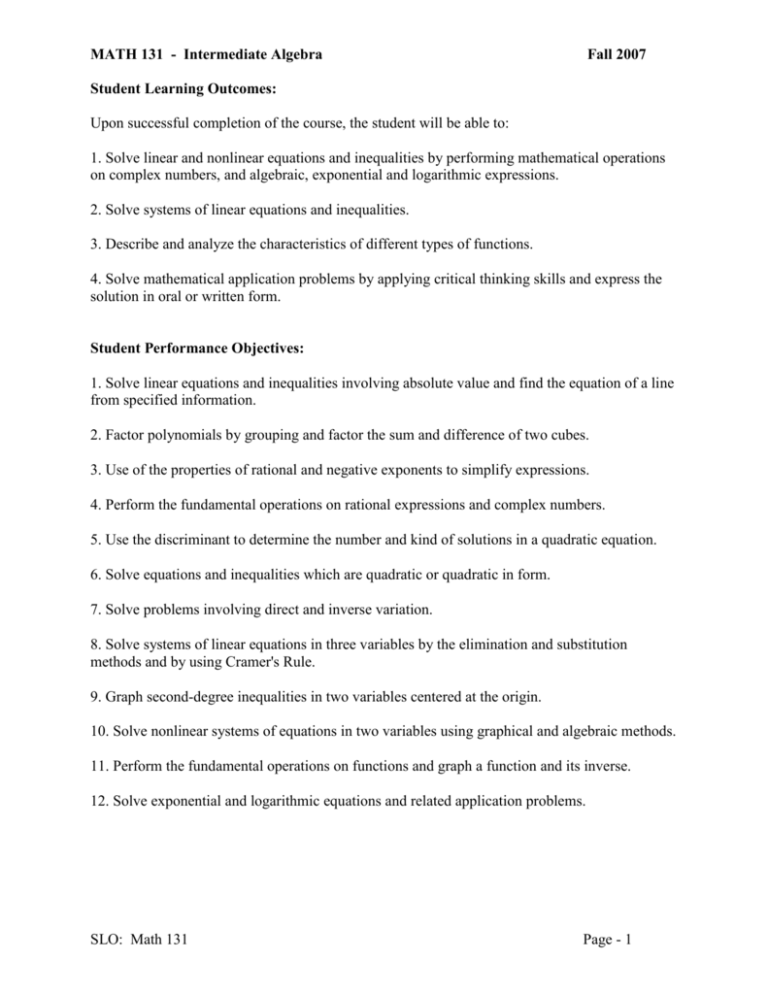
MATH 131 - Intermediate Algebra Fall 2007 Student Learning Outcomes: Upon successful completion of the course, the student will be able to: 1. Solve linear and nonlinear equations and inequalities by performing mathematical operations on complex numbers, and algebraic, exponential and logarithmic expressions. 2. Solve systems of linear equations and inequalities. 3. Describe and analyze the characteristics of different types of functions. 4. Solve mathematical application problems by applying critical thinking skills and express the solution in oral or written form. Student Performance Objectives: 1. Solve linear equations and inequalities involving absolute value and find the equation of a line from specified information. 2. Factor polynomials by grouping and factor the sum and difference of two cubes. 3. Use of the properties of rational and negative exponents to simplify expressions. 4. Perform the fundamental operations on rational expressions and complex numbers. 5. Use the discriminant to determine the number and kind of solutions in a quadratic equation. 6. Solve equations and inequalities which are quadratic or quadratic in form. 7. Solve problems involving direct and inverse variation. 8. Solve systems of linear equations in three variables by the elimination and substitution methods and by using Cramer's Rule. 9. Graph second-degree inequalities in two variables centered at the origin. 10. Solve nonlinear systems of equations in two variables using graphical and algebraic methods. 11. Perform the fundamental operations on functions and graph a function and its inverse. 12. Solve exponential and logarithmic equations and related application problems. SLO: Math 131 Page - 1 Course Content Outline: Properties of Real Numbers: Define and use the terms: set, subset, natural numbers, rational numbers, basic axioms of equality, the properties of real numbers, and the prime and composite numbers. Add, subtract, multiply and divide signed numbers. Polynomials: Define the terms: exponent, base, power, coefficient, polynomial, degree; be able to simplify polynomial expressions and exponential expressions and exponential expressions; be able to factor quadratics, polynomial expressions, sum and difference of cubes, and deal with factoring by grouping; be able to evaluate an algebraic expression for given values of the variables. Synthetic Division. Fractions: Be able to add, subtract, multiply, divide, and simplify algebraic fractions; and to simplify complex fractions. First-Degree Equations and Inequalities - One Variable: Solve linear equalities and inequalities in one variable; "translate" verbal problems into mathematical sentences. Exponents, Roots and Radicals: Use laws of exponents, perform algebraic operations and simplify expressions including integral, fractional, negative and zero exponents; use scientific notation; change from radical form to exponential form, and conversely; change an algebraic expression containing radicals to simplest radical form; add, subtract, multiply and divide complex numbers. Second-Degree Equations - On Variable: Identify a quadratic equation and select a method for solving it by extraction of roots, factoring, completing the square, quadratic formula; use the discriminant to determine whether roots of a quadratic equation are equal, real, irrational, complex; solve an equation involving radical expressions; form a quadratic equation for which the roots are given. Solve quadratic inequalities. Functions and Graphs II: Graph the set of points which an algebraic function represents, after investigating domain and range; direct, inverse and joint variation, translating word problem into equations and solving practical problems; graph quadratic inequalities. Simultaneous Systems: Solve two linear equations of two unknowns by graphing, linear combinations, substitutions and determinants; evaluate a second or third order determinant; solve three first degree equations on three unknowns by linear combinations and by determinants; solve a system of a linear and a quadratic equation or two quadratic equations by substitution or linear combinations. Exponential and Logarithmic Functions: Sketch an exponential or logarithmic function; change an expression form logarithmic to exponential form, and from exponential to logarithmic form; apply the three basic laws of logarithms; use 4-place logarithm tables to multiply, divide, find roots, and find powers; use linear interpolation where needed; use logarithms in compound interest problems. SLO: Math 131 Page - 2 SLO: Math 131 Page - 3
